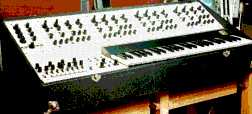Xpander an Oberheim blockbuster, a 6 voice polyphonic analogue subtractive module with 12 VCOs. This one is almost frighteningly good. Oberheim were the one major American company that did not take part in the original MIDI negotiations, preferring to 'sit on the fence'.
They finally took the plunge with this model & redefined MIDI for ever. Key Zones, familiar to everyone now, came in with this machine along with full Matrix Modulation. Features were introduced that no-one has yet surpassed.
Fully multi-timbral, though with only six voices, what you can do with those voices is quite something. Each can be controlled by individual CV & Gate inputs. The results can then be sent by MIDI to other instruments etc. They can also each be set to respond to specific groups of notes &/or MIDI channels.
Common enough now, but no-one else had it then. Each voice has an individual output & can be programmed in the stereo mix.
Matrix Modulation has so many possibilities that mastering them all can take a lot of thought & practice. Any modulation or control source can be sent to any destination. The amount can be set individually for every connection & every voice. Few other machines can do this even now. The VCFs are multi-mode, several modes are distinctly different, clever.
As always Oberheim took Curtis chips & imbued them with their own sound.
Vacuum fluorescent alphanumeric displays (VFDs) show as much as possible of the large amount of information used in setting this beast up. Together with the usual LED indicators etc. Two eight bit CPUs are used, for the main board and the voice board. A single master clock drives both.
Auto-tune has been taken one stage further than everyone else. Each of the twelve VCOs has a chip temperature output. Read by the Voice CPU & used to correct the individual CVs for each voice. This results in an almost digital accuracy of pitch. Once Auto-tune has been pressed once it usually does not need to be used again, often for days.
A very definite & potentially serious problem exists. The Digital to Analogue Converter (DAC) is a multiplying fourteen bit type inherited from the OB-8. It was already obsolete when that model was in production, they had probably brought a large stock cheap & wanted to use them up.
No modern DAC that we have found will work, most are not multiplying & none are 14 bit. The multiplying feature is essential for the thermally tracked CVs.
A clever & dedicated engineer can possibly build a PCB to adapt a modern part but it will have to be good to maintain the tuning stability. Maybe someone has done it, all credit to them if they have. This instrument deserves to survive.
The usual problem with obtaining analogue custom ICs can plague this model. VFDs may also be a problem. Be very careful when working inside not to break them.
 ©
© 

 SEM (Synthesiser Expander Module), a neat monophonic analogue subtractive synthesiser module. Very sought after.
SEM (Synthesiser Expander Module), a neat monophonic analogue subtractive synthesiser module. Very sought after.
 Several keyboard modes are available, it took some time for most of the synthesiser world to catch up with this feature.
Several keyboard modes are available, it took some time for most of the synthesiser world to catch up with this feature.

 Like the modular Four Voice & Eight Voice two stage regulation is used. This however is not enough to make the tuning completely stable.
Like the modular Four Voice & Eight Voice two stage regulation is used. This however is not enough to make the tuning completely stable.
 OB-8, OB-Xa's successor, more reliable, better tuning. Split and layered sounds with more functions. Both models have spares problems, ensure everything works before buying. Again service access is good.
OB-8, OB-Xa's successor, more reliable, better tuning. Split and layered sounds with more functions. Both models have spares problems, ensure everything works before buying. Again service access is good.


 Matrix-6, NOT a successor to the Xpander or Matrix 12. Six voice polyphonic with 5 octave keyboard. A pseudo analogue subtractive, using DCOs (programmable dividers) instead of VCOs. Design does not resemble the previous two.
Matrix-6, NOT a successor to the Xpander or Matrix 12. Six voice polyphonic with 5 octave keyboard. A pseudo analogue subtractive, using DCOs (programmable dividers) instead of VCOs. Design does not resemble the previous two.


